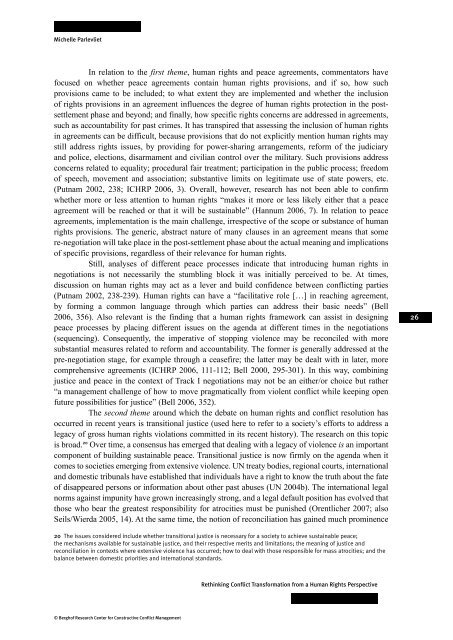Rethinking Conflict Transformation from a Human Rights Perspective
Rethinking Conflict Transformation from a Human Rights Perspective
Rethinking Conflict Transformation from a Human Rights Perspective
You also want an ePaper? Increase the reach of your titles
YUMPU automatically turns print PDFs into web optimized ePapers that Google loves.
Michelle Parlevliet<br />
In relation to the first theme, human rights and peace agreements, commentators have<br />
focused on whether peace agreements contain human rights provisions, and if so, how such<br />
provisions came to be included; to what extent they are implemented and whether the inclusion<br />
of rights provisions in an agreement influences the degree of human rights protection in the postsettlement<br />
phase and beyond; and finally, how specific rights concerns are addressed in agreements,<br />
such as accountability for past crimes. It has transpired that assessing the inclusion of human rights<br />
in agreements can be difficult, because provisions that do not explicitly mention human rights may<br />
still address rights issues, by providing for power-sharing arrangements, reform of the judiciary<br />
and police, elections, disarmament and civilian control over the military. Such provisions address<br />
concerns related to equality; procedural fair treatment; participation in the public process; freedom<br />
of speech, movement and association; substantive limits on legitimate use of state powers, etc.<br />
(Putnam 2002, 238; ICHRP 2006, 3). Overall, however, research has not been able to confirm<br />
whether more or less attention to human rights “makes it more or less likely either that a peace<br />
agreement will be reached or that it will be sustainable” (Hannum 2006, 7). In relation to peace<br />
agreements, implementation is the main challenge, irrespective of the scope or substance of human<br />
rights provisions. The generic, abstract nature of many clauses in an agreement means that some<br />
re-negotiation will take place in the post-settlement phase about the actual meaning and implications<br />
of specific provisions, regardless of their relevance for human rights.<br />
Still, analyses of different peace processes indicate that introducing human rights in<br />
negotiations is not necessarily the stumbling block it was initially perceived to be. At times,<br />
discussion on human rights may act as a lever and build confidence between conflicting parties<br />
(Putnam 2002, 238-239). <strong>Human</strong> rights can have a “facilitative role […] in reaching agreement,<br />
by forming a common language through which parties can address their basic needs” (Bell<br />
2006, 356). Also relevant is the finding that a human rights framework can assist in designing<br />
peace processes by placing different issues on the agenda at different times in the negotiations<br />
(sequencing). Consequently, the imperative of stopping violence may be reconciled with more<br />
substantial measures related to reform and accountability. The former is generally addressed at the<br />
pre-negotiation stage, for example through a ceasefire; the latter may be dealt with in later, more<br />
comprehensive agreements (ICHRP 2006, 111-112; Bell 2000, 295-301). In this way, combining<br />
justice and peace in the context of Track I negotiations may not be an either/or choice but rather<br />
“a management challenge of how to move pragmatically <strong>from</strong> violent conflict while keeping open<br />
future possibilities for justice” (Bell 2006, 352).<br />
The second theme around which the debate on human rights and conflict resolution has<br />
occurred in recent years is transitional justice (used here to refer to a society’s efforts to address a<br />
legacy of gross human rights violations committed in its recent history). The research on this topic<br />
is broad. 20 Over time, a consensus has emerged that dealing with a legacy of violence is an important<br />
component of building sustainable peace. Transitional justice is now firmly on the agenda when it<br />
comes to societies emerging <strong>from</strong> extensive violence. UN treaty bodies, regional courts, international<br />
and domestic tribunals have established that individuals have a right to know the truth about the fate<br />
of disappeared persons or information about other past abuses (UN 2004b). The international legal<br />
norms against impunity have grown increasingly strong, and a legal default position has evolved that<br />
those who bear the greatest responsibility for atrocities must be punished (Orentlicher 2007; also<br />
Seils/Wierda 2005, 14). At the same time, the notion of reconciliation has gained much prominence<br />
20 The issues considered include whether transitional justice is necessary for a society to achieve sustainable peace;<br />
the mechanisms available for sustainable justice, and their respective merits and limitations; the meaning of justice and<br />
reconciliation in contexts where extensive violence has occurred; how to deal with those responsible for mass atrocities; and the<br />
balance between domestic priorities and international standards.<br />
© Berghof Research Center for Constructive <strong>Conflict</strong> Management<br />
<strong>Rethinking</strong> <strong>Conflict</strong> <strong>Transformation</strong> <strong>from</strong> a <strong>Human</strong> <strong>Rights</strong> <strong>Perspective</strong><br />
26
















